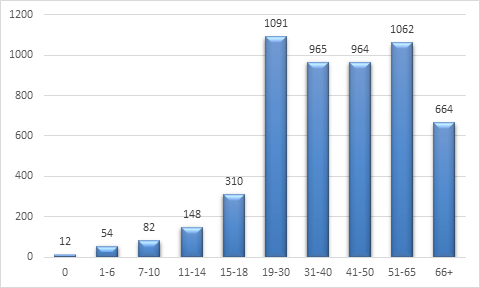Gov't for Enabling Civil Servants to Work From Home
ZAGREB, October 22, 2020 - Due to the deteriorating epidemiological situation, the government has tasked state administration bodies and offices and other public services to take measures in an effort to prevent the spread of coronavirus and arrange for work to be done from home or in rosters where possible.
The government on Thursday authorised Minister of Justice and Public Administration Ivan Malenica to adopt, following prior approval from the Prime Minister, a binding instruction identifying measures related to the epidemiological situation.
"The instruction will, depending on the epidemiological situation, in detail prescribe cases and possibilities to work from home and arrange work in rosters with the aim of ensuring continual and regular state administration duties to be performed while trying to prevent the spread of Covid-19," said Malenica.
This decision will apply to public services, with the exception of health, science, education and social welfare, which are regulated with special regulations. This will also not apply to police officers, civil protection organisations and members of the Armed Forces who will conduct their duties in accordance with instructions from the police director, the military chief-of-staff and the director of civil protection.
The government adopted a decision on launching negotiations on an annexe to the Collective Agreement for state administration and public servants, and in that regard appointed its members to negotiation committees which will be headed by Minister for Labour, Pension System, Family and Social Policy Josip Aladrovic.
The negotiations on the most part refer to the amount of Christmas bonuses but will also discuss base wage indices for next year, the state secretary in the labour ministry, Dragan Jelic, explained.
The government defined the minimum financial standards for the decentralisation of health institutions for Zagreb, Krapina-Zagorje, Sisak-Moslavina, Zadar and Istria counties and adopted a decision on the reallocation of these funds, while the total amount for decentralisation activities in 2020 remains unchanged.
Project to Upgrade Port of Baska Launched
ZAGREB, October 22, 2020 - An agreement on the extension of the port of Baska on the northern Adriatic island of Krk was signed on Thursday. The project is worth HRK 41.1 million, of which HRK 39.7 million will be provided by the EU and the rest by the county port authority.
The work will be carried out by the Aqua Mont Service company and will include extending the existing quay and ensuring necessary protection of the waters within the port area and appropriate berths for passenger ships. The deadline for completion of the work is December 2023.
The signing ceremony was attended by the Minister of the Sea, Transport and Infrastructure, Oleg Butkovic, who said that a large cycle of investment in ports and coastal zones had been launched in all seven coastal counties.
"We are talking over a billion kuna worth of active projects with 85% of financing provided by EU grants," Butkovic said, adding that five such projects were being carried out in Primorje-Gorski Kotar County.
(€1 = HRK 7.57)
Croatia Among 17 EU Countries with Budget Surplus in 2019
ZAGREB, October 22, 2020 - Croatia and 16 other EU member states recorded a budget surplus in 2019 but the public debt was above the prescribed upperlimit of 60% of GDP, shows a second Eurostat estimate released on Thursday.
The EU27 in 2019 recorded an average budget deficit of 0.5% of GDP, down 0.1 percentage point from the previous estimate, released in April.
In 2018 the deficit was 0.4%.
The euro area saw a budget deficit of 0.6% of GDP in 2019 and of 0.5% in 2018, which confirms the previous estimate, released in April.
Budget revenue expressed as a share in GDP was 46.1% in 2019 in the EU while budget expenses accounted for 46.7% of GDP.
In the euro area budget revenue was 46.4% and expenses 47.1% of GDP, Eurostat said.
Denmark has highest surplus
A total of 17 EU countries recorded a budget surplus, with Denmark reporting the highest, of 3.8%, followed by Luxembourg (2.5%), Bulgaria (1.9%) and the Netherlands (1.7%).
A budget surplus of below one percent was reported by a group of countries led by Austria, which reported a budget surplus of 0.7%.
Croatia had a general government surplus of 0.4% of GDP, with the surplus rising by HRK 112 million to HRK 962 million. In 2018 the share of the budget surplus in GDP was 0.2%.
A budget deficit at the upper allowed limit of 3% of GDP was reported by France, while Romania exceeded it with a budget deficit of 4.4%.
EU, euro area debt down in 2019
In the EU27 the public debt, expressed as a share in GDP, in 2019 dropped to 77.6% from 79.6% in 2018, with the April estimate having been slightly revised down.
In the euro area the public debt in 2019 was 84% of GDP, which confirms the April estimate.
As for 2018, the estimate was revised slightly up, to 85.8% of GDP.
Public debt highest in Greece
A total of 11 EU countries in 2019 crossed the upper allowed level of debt expressed as a share in GDP of 60%.
The highest debt to GDP ratio was reported by Greece, 180.5%, Italy, 134.7%, and Portugal, 117.2%.
Croatia's debt-to-GDP ratio in 2019 was 72.8% or HRK 292.9 billion. In April the share of debt was estimated at 73.2% of GDP and the debt amounted to 293.02 billion.
In 2018 Croatia's public debt totalled 74.3% of GDP, shows the latest estimate. In April it was estimated at 74.7%.
In 2019 Estonia had the lowest debt-to-GDP ratio, of 8.4%.
Croatia to Receive €1.02bn from EU SURE Instrument
ZAGREB, October 22, 2020 - By the end of this year Croatia will receive €490 million from the EU SURE instrument for temporary support to mitigate unemployment risks in an emergency following the outbreak of the coronavirus pandemic, the government said on Thursday, adding that a total of €1.02 billion has been approved for Croatia.
At today's cabinet meeting, Finance Minister Zdravko Maric was authorised to sign a loan agreement with the EU for this temporary support.
The SURE instrument was established by decision of the Council of the EU in May with the aim of providing financial assistance of up to €100 billion in the form of loans from the EU to affected member states to address sudden increases in public expenditure for the preservation of employment.
To finance these loans, the European Commission will borrow money on financial markets and lend it to member states under favourable terms. The first tranche of €17 billion was conducted a few days ago, and the interest was ten times higher, Maric said.
"The instrument is designed for short work time schemes and similar measures to help member states protect jobs and employed and self-employed people from the risk of unemployment and loss of income. All member states have signed a guarantee agreement to date, whereby the SURE instrument has become operational," Maric said.
He said that Croatia had applied for this funding to address sudden and serious increases in expenditures connected with subsidies to preserve jobs and support for shorter work time.
"A loan of €1.02 billion is available to Croatia, with a maximum average maturity of 15 years and an availability period for financial support of 18 months. Financial support can be used through a maximum of eight instalments which can be paid by one or more tranches. These are very favourable loans, and a total of €490 million will be paid to Croatia by the end of this year, which will be included in the budget revision and which is about 48% of the allocation," Maric said.
The government also decided to include micro and small businesses in the state aid programme for the sea, transport and transport infrastructure sector to help them cope with the crisis caused by the coronavirus pandemic.
Three 9th Round Croatian First League Matches Postponed due to COVID-19
October 22, 2020 - As COVID-19 rips through Croatia, three 9th round Croatian First League matches meant to be played this weekend have been postponed.
It all began yesterday when Lokomotiva Zagreb announced they still cannot compete as the coronavirus has penetrated its dressing room. After postponing the match against Osijek last weekend, the 9th round match against Hajduk, which was supposed to be played on October 24, at Kranjčevićeva, is also postponed. The match will take place on the first possible date, which will be decided later.
The Croatian Football Federation stated the following explanation:
"On October 21, 2020, NK Lokomotiva submitted a notification that four players tested positive for coronavirus after testing the entire team, and two more have an epidemiological measure of self-isolation. Therefore, NK Lokomotiva cannot continue the regular competition and requests the postponement of the 9th round match in the HT First League between Lokomotiva - Hajduk.
Following the regulations of the HNS and the decision of the Competition Commission of the HNS from the session held on August 6, 2020, which authorizes the commissioners of the competition to postpone a particular match in case there are six or more players of the same club in self-isolation; based on the request of NK Lokomotiva, a decision was made to postpone the match. According to the provisions of the Rules on Football Competitions and the Propositions of Competitions, postponed matches must be played in the first possible free period, on which a decision will be made later."
Furthermore, Gorica announced today that five players have tested positive for coronavirus, so the match supposed to be played against Rijeka on Sunday has also been postponed.
"The 9th round of the HT First League, which was supposed to be played at the City Stadium in Velika Gorica, was postponed because the results of individual testing confirmed coronavirus infection in five HNK Gorica players, and three more have a prescribed measure of self-isolation.
Based on the request of HNK Gorica, following the regulations of HNS and the decision of the Competition Commission of HNS, a decision was made to postpone the match."
But that's not all.
After the Gorica-Rijeka match was postponed, the same happened with the match between Istria and Osijek.
"The match between Istra 1961 and Osijek is postponed.
The test results confirmed the coronavirus in seven players of the Osijek Football Club. To avoid spreading the infection further, it is necessary to postpone the match until the competent epidemiologists decide on further action."
You can see the Croatian First League table HERE.
To read more about sport in Croatia, follow TCN's dedicated page.
Beros: Week Behind Us With Highest Number of Infections and Deaths
ZAGREB, October 22, 2020 - Health Minister Vili Beros said at a cabinet meeting on Thursday that despite continual measures and responsible behaviour by most citizens, the past week has seen the largest number of people infected with coronavirus and related deaths.
"We cannot be pleased with the current epidemiological situation or with the irresponsible behaviour of some individuals. All of that puts a lot of pressure on epidemiologists and other health workers, physicians and nurses, hospitals and the health system overall," said Beros.
He added that today, the 241st day since the outbreak of coronavirus in Croatia, a total of 1,563 new cases were registered and that currently there are 7,380 active cases with 661 patients receiving hospital treatment.
In the past week 686 patients were admitted to hospital while 448 were released. Compared to the week before, there is a noticeable increase in the number of people being hospitalised.
Currently 610 health workers are infected and 1,341 are in self-isolation.
"Despite the increase in the number of new cases no major hotspots have emerged and on the most part they are micro-clusters and involve small groups," he added.
Hospitals increasing capacity to cater for coronavirus patients
Epidemiologists keep recording infections that are connected with family gatherings, parties, choirs, going out, training and sport events, from where they spread into the working community. A significant portion of those infected have had contacts with people who were previously infected.
Beros said that he expects appropriate participation by all stakeholders in the health system. Primary health care has the obligation to work on prevention and curbing the spread of the epidemic, he said.
We are in a situation when we all need to do our bit, just like medical staff in intensive care units have been doing for months, he underscored.
Hospitals have been instructed to increase their capacity to cater for Covid-19 patients and to provide daily reports of the number of health workers who have been infected as well as schedule examinations for patients whose diagnosis and condition do not allow deferrals.
Gov't to Provide HRK 7.5bn in Grants for Wages in Private Sector this Year
ZAGREB, October 22, 2020 - Prime Minister Andrej Plenkovic said on Thursday that government allocations for workers' wages in the private sector would reach HRK 7.5 billion kuna by the end of this year.
Since the outbreak of the COVID-19 pandemic, the government has allocated HRK 6.85 billion to help private-sector companies ensure wages for their workers.
The proof that the government measures have been successful is data from the Croatian Pension Insurance Agency (HZMO) showing that there are currently 3,200 more pension insurees than at the outbreak of the corona crisis in late February, the premier said.
"The measures have been meaningful and efficient," he said, adding that they have helped many companies to survive and retain workers.
The PM said that a revision of the 2020 budget would be drafted next week.
Croatia Ready to Set Up 2,360 Beds in Makeshift Hospitals if Necessary
ZAGREB, October 22, 2020 - Interior Minister Davor Bozinovic said on Thursday that the authorities were preparing additional beds in makeshift facilities for the treatment of COVID-19 patients, following a surge in the number of daily cases of the coronavirus infection.
For this purpose, Zagreb's Arena Centre, Split's Spaladium hall, Rijeka's Dvorana Mladosti venue as well as similar locations in Varazdin and Osijek have been selected for installing a total of 2,360 beds, if necessary.
Bozinovic informed the government that those capacities could be prepared to take in COVID-19 patients within 48 hours.
He also called on the Croatians to avoid all the uneccesary contacts so as to help efforts to curb the infection.
A Young Man from Vodnjan is Collecting Donations for Croatian Debtors
October 22, 2020 – Two weeks ago, a 27-year-old man from Vodnjan and one girl started collecting donations for Croatian debtors in a Facebook group.
As 24sata reports, since then, he has received hundreds of phone calls and text messages in a Facebook group that he launched called "Blocked and debted people let’s help each other" ("Blokirani i ovršeni pomozimo jedni drugima"). He has already gathered more than 1000 people in that group, and the number continues to grow.
As we reported earlier from Hina, the moratorium on debt enforcements ended on Monday, October 19, and the total number of enforcement debtors now in Croatia is 244,865. Data from the Financial Agency's (FINA) system for execution of enforcement over monetary assets have shown that the largest number of enforcement debtors, 109,000 or 46 percent of citizens with blocked bank accounts, owed up to 10,000 kunas, while the total amount of their debt was 396 million kunas.
The goal of this Facebook group is to help the people who faced foreclosures to get rid of their debts by collecting donations for the most urgent cases.
"I want every kuna to get into the right hands. Every day for the past two weeks, I have been replying for hours to messages coming to my group and trying to help as best I can," said Dražen Gluvak from Vodnjan.
"We are here to help each other to be free, to sleep peacefully, and finally get rid of our problems and debts, and ultimately get rid of moneylenders like FINA and other paying agencies. Let's help each other," reads the description of the Facebook page.
Dražen says he is very emotional when it comes to unfortunate human destinies.
"The donation is paid directly to the account of one person within a month. Some people have a problem, but also those who are immediately ready to pay a donation to help as soon as possible. In the past two weeks, we have helped a lady for whom we collected about 1,000 kuna so far, and she needs 5,000 kuna to be unblocked. She begged us for help because of a debt she just can't pay. The money was paid directly to her account. Everything works so that the person who needs help sends us all the documentation from FINA on enforcement and then we start the action of help," Dražen explained.
He says that people pay as much as they can and that the goal is to help as many people as possible. If everyone paid only a small amount, at least the amount needed for one coffee, a lot of people would be saved, he points out.
He added that he is glad that more and more people are joining the group.
"People want change, they want to help. Those who are in debt want to fall asleep at least once without the fear of tomorrow. If I were rich, I would help everyone. People in the group are not immune to other people's misfortune and want to help, even with a few kunas, because no one knows if they will find themselves in the same situation tomorrow and cry out for help," the young man from Vodnjan said.
For the latest travel info, bookmark our main travel info article, which is updated daily.
Read the Croatian Travel Update in your language - now available in 24 languages.
Official COVID-19 in Croatia Weekly Report October 12-18, 2020
October 22, 2020 - The latest official COVID-19 in Croatia weekly report has been released by the Koronavirus government website, covering October 12 to October 8.
| Tested | Confirmed cases | Active cases | Recovered | Self-isolation | Hospitalized | On a respirator | Deaths | |
| 400 636 (+3636*) | 25973 (+393*) | 5070 | 20529 | 21329 | 571 | 35 (+5*) | 374 (+11*) | |
| A total of 267 people died in this epidemic wave. Most of the deceased had significant comorbidities or were of advanced age. The average age of the deceased in this epidemic wave is 77.1 years. One hundred and eight people died on a respirator. | ||||||||
* in the last 24 hours
There are currently 26 testing places in the Republic of Croatia that perform RT-PCR analysis and collect samples. All processed samples enter national Croatian Health Insurance Institute platform, which is accessible to all county public health institutes. County public health institutes submit data about positive cases, sources of infection and hotspots as part of their daily reports to the Croatian Institute of Public Health. The Croatian Institute of Public Health collects information about hotspots, hospital treatment of COVID-19 positive persons, COVID-19 positive patients on respirators and the deceased. You can find more about the test centers on the link.
Epidemiological indicators on 19th of October 2020
- Cumulative 7-day rate for the Republic of Croatia: 130,9/100 000
- Cumulative 14-day rate for the Republic of Croatia: 200,0/100 000
- Counties with a cumulative 7-day rate greater than 50/100 000 inhabitants: Grad Zagreb, BBŽ, BPŽ DNŽ, KŽ, KKŽ, KZŽ, LSŽ, MŽ, OBŽ, PSŽ, PGŽ, SMŽ, SDŽ, ŠKŽ, VŽ, VPŽ, VSŽ, Zagrebačka
- Counties with a cumulative 14-day rate greater than 100/100 000 inhabitants: Grad Zagreb, BBŽ, DNŽ, KŽ, KZŽ, LSŽ, MŽ, OBŽ, PSŽ, SMŽ, SDŽ, VŽ, VPŽ, VSŽ, Zagrebačka
- Total number of tests in the last week: 39 660
- Share of positive tests in the total number of tests in the last week: 13,5%
- Total number of tests and share of positive tests in total number of tests: 400 636; 6,5%
- The number of new cases in intensive care per 100,000 inhabitants in the last 7 days: 0,68/100 000
- Number of deaths in the last week: 47
- Total death rate per 1 000 000 population: 91,5/1 000 000
Epidemiological situation in Croatia
Geographical distribution of new COVID-19 cases by counties
In a two-week period from 13th October to 19th of October all counties recorded new cases of COVID-19 disease. The highest number of new cases are recorded in the City of Zagreb, followed by the Splitsko - dalmatinska and Osječko-baranjska County. The lowest number of new cases were recorded in Istarska and Koprivničko-križevačka County. The Krapinsko-zagorska County also has the highest 14-day rate, followed by Ličko-senjska and Međimurska County.
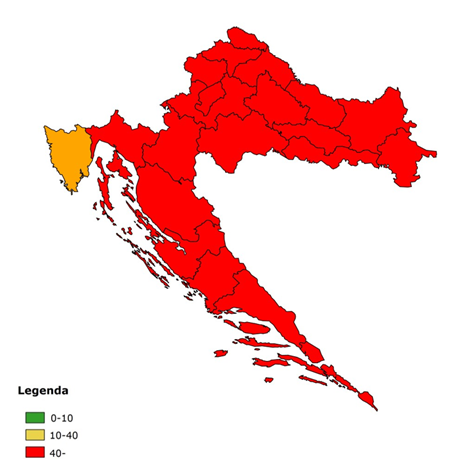
Figure 1. 14-day rate by counties in Croatia on October 19, 2020.
| County | |
| IC | 28,7 |
| KKC | 66,8 |
| ŠKC | 79,9 |
| PGC | 81,3 |
| BPC | 82,1 |
| ZADARSKA | 83,3 |
| BBC | 151,1 |
| PSC | 159,1 |
| VC | 164,7 |
| SDC | 187,9 |
| ZAGREBAČKA | 195,2 |
| SMC | 199,9 |
| DNC | 209,5 |
| OBC | 226,9 |
| VSC | 233,2 |
| KC | 235,4 |
| VŠC | 272,4 |
| CITY OF ZAGREB | 297,6 |
| MC | 308,4 |
| LSC | 345,3 |
| KZC | 460,3 |
| TOTAL | 200,0 |
Figure 1. 14-day rate by counties in Croatia on October 19, 2020.
Epidemic by weeks, from 28th – 34th week of the epidemic
Table 1 shows the epidemiological indicators by epidemic week. The data shows that one of the most important epidemiological indicators - the rate of confirmed cases and the share of positive ones show a positive trend in the period from 28th to 31st week, while in the 32nd and 34th week they grow again with a very large jump at 33rd and 34th week compared to the week before. The confirmed case rate has been steadily declining since week 31 when it stood at 31,2 to grow again at 32nd and 34th week. The number of new cases increased by 84.8% compared to the week before. The total number of tests, after a slight decline in 32nd and 33rd week, it rose again in 34th week and a total of 38,485 tests were performed. The proportion of positive individuals in total testing also declined by 31st week, and increased at 32nd and 34th week.

Table 1. Overview of the number of confirmed cases by weeks, from week 28 th to 34th
Table 2 shows a set of indicators related to the severity of the clinical picture and the characteristics of deaths. The table shows that in the period from 28th to 31st week, there has been an increase, and at 32nd and 33rd week a slight decrease in the number of cases on the respirator. At 34th week, there was a significant increase in the number of cases on the respirator, but the share of cases on the respirator in the total and the weekly number of cases did not increase. The share of hospitalized cases in the weekly number of cases ranges from a minimum of 35% to a maximum of 77.1%. The average age of who died does not oscillate significantly. The death rate in the latter stagnated from 29th to 33rd week and increased in 34th week.

Table 2. Overview of patients on respirator and deaths by weeks, from week 28 to 34
Table 3 shows the incidence of the 7-day rate in the two last weeks with a limit of 50/100 000 inhabitants, which in some countries is taken as one of the criteria in assessing the epidemiological situation. After the epidemiological situation calmed down in early October, due to the re-influx of new cases, rates rose again in most counties.
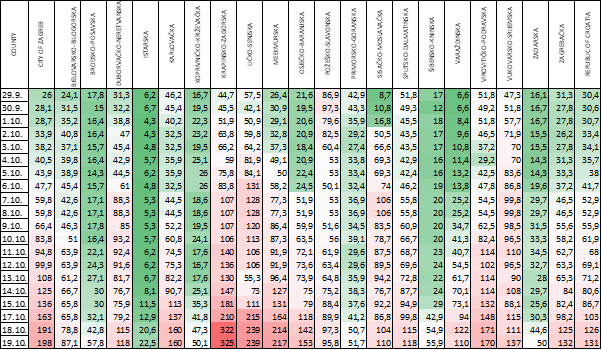
Clinical aspects - Hospitalizations and severity of clinical picture for the period from 13th October to 19th of October
Figure 2 shows the relationship between the daily number of confirmed cases and the daily number of hospitalized cases. Number of hospitalized cases per day ranged between a minimum of 54 and a maximum of 117, while the share of hospitalized cases in the total daily number of confirmed cases ranged from 7.7% to 18.1%.
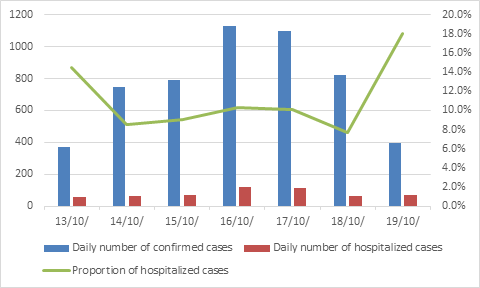
Figure 2. Overview of the daily number of confirmed and hospitalized cases from 13th to 19th of October
Figure 3 shows the proportion of hospitalized in the total number of weekly cases. Of the total number of confirmed cases in a given weekly period, 10.3% were hospitalized, which is an decrease compared to last week's 11.9%. In the same period, 28 people were put on a respirator, which makes 0,5% of the total number of confirmed cases. On October 19, there were 35 people on the respirator, or 0.7% of the total number of active cases.
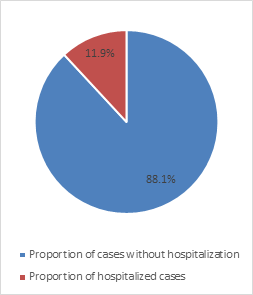
The graph in Figure 4 shows that the slope of the curve of confirmed cases is followed by the curve of cured cases, while the curve of active cases, in addition to some ascending, shows stagnation in certain periods related to the continuation of the first wave of the epidemic in Croatia. After changing the duration of isolation of patients, a sharp decline in the number of active cases is recorded and after which the number of active cases stagnated for two weeks, only to grow again in the last two weeks.
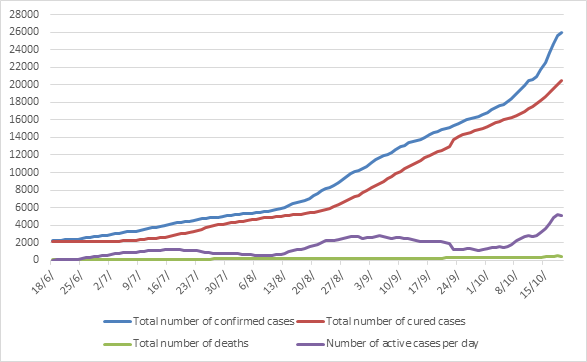
Figure 4. Movement of the total number of cases, recovered, deceased and active number of cases from 18th of June till 19th of October
Age-sex distribution of COVID-19 deaths
A total of 267 people died in this wave of epidemics. Most of the people who died had significant comorbidities or were of advanced age. The mean age of the deceased in this wave of epidemics is 77.1 years. One hundred and eight people died on a respirator. An overview of the situation is given in Table 4 and Figure 5.
| AGE GROUP | 30-39 | 40-49 | 50-59 | 60-69 | 70-79 | 80-89 | 90-99 | 100+ |
| MEN | 0 | 1 | 13 | 28 | 56 | 42 | 9 | 0 |
| WOMEN | 1 | 0 | 0 | 17 | 32 | 50 | 17 | 1 |
Table 4. Died people by age and gender in the period from 29th of June till 19th of October
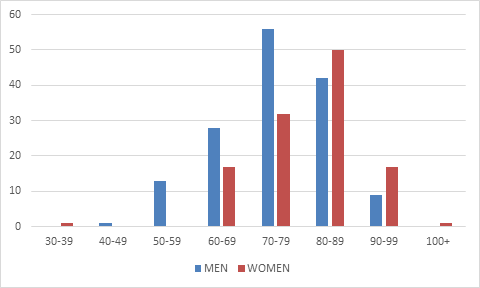
Figure 5. Age and sex distribution of deaths from COVID-19 in the period 29th of June to 19th of October 2020
Deaths for the period from 13th to 19th of October
In the last week, 27 people died, of which 15 (55.6%) were on a respirator. The distribution by age and sex in the last weeks is shown in Table 5, and by counties in Table 6.
| AGE GROUP | 50-59 | 60-69 | 70-79 | 80-89 | 90-99 |
| MEN | 0 | 2 | 5 | 6 | 10 |
| WOMEN | 1 | 0 | 2 | 7 | 8 |
Table 5. Distribution by age and sex of persons who died in the last week
| County | Number of new cases in the period 13.10.-19.10. | Incidence of new cases in the last 7 days on 100 000 inhabitants | Number of deaths in the period 13.10.-19.10. | Total number of deaths | Total mortality rate at 1,000,000 inhabitants |
| CITY OF ZAGREB | 1590 | 197,6 | 15 | 71 | 88,3 |
| BJELOVARSKO-BILOGORSKA | 94 | 87,1 | 4 | 10 | 92,7 |
| BRODSKO-POSAVSKA | 81 | 57,8 | 0 | 6 | 42,8 |
| DUBROVAČKO-NERETVANSKA | 143 | 118,0 | 1 | 16 | 132,0 |
| ISTARSKA | 47 | 22,5 | 1 | 14 | 67,1 |
| KARLOVAČKA | 187 | 160,1 | 3 | 7 | 59,9 |
| KOPRIVNIČKO-KRIŽEVAČKA | 54 | 50,1 | 0 | 18 | 167,1 |
| KRAPINSKO-ZAGORSKA | 407 | 324,7 | 2 | 7 | 55,8 |
| LIČKO-SENJSKA | 108 | 239,0 | 4 | 6 | 132,8 |
| MEĐIMURSKA | 238 | 216,5 | 1 | 1 | 9,1 |
| OSJEČKO-BARANJSKA | 425 | 153,3 | 2 | 32 | 115,4 |
| POŽEŠKO-SLAVONSKA | 65 | 95,8 | 0 | 6 | 88,4 |
| PRIMORSKO-GORANSKA | 147 | 51,7 | 1 | 17 | 59,8 |
| SISAČKO-MOSLAVAČKA | 164 | 110,4 | 3 | 11 | 74,0 |
| SPLITSKO-DALMATINSKA | 530 | 118,3 | 5 | 78 | 174,1 |
| ŠIBENSKO-KNINSKA | 56 | 55,9 | 0 | 8 | 79,9 |
| VARAŽDINSKA | 184 | 110,2 | 0 | 4 | 24,0 |
| VIROVITIČKO-PODRAVSKA | 128 | 170,1 | 1 | 12 | 159,5 |
| VUKOVARSKO-SRIJEMSKA | 212 | 137,3 | 0 | 17 | 110,1 |
| ZADARSKA | 84 | 50,0 | 0 | 9 | 53,5 |
| ZAGREBAČKA | 408 | 131,8 | 4 | 24 | 77,6 |
| TOTAL | 5352 | 130,9 | 47 | 374 | 91,5 |
Table 6. New patients and deaths in the last week and total deaths
Epidemiological situation in Croatia
In the last week, new cases have been reported in all counties of continental and coastal Croatia. The highest 7-day rates on 19th October were recorded in continental Croatia, in Krapinsko-zagorska (324.7) and Međimurska County (216.5), followed by the City of Zagreb (197.6) and Virovitičko-podravska (170.1) and Karlovačka County (160.1). In coastal counties, the lowest rate was recorded for a longer period of time in Istarska County (22.5), while higher rates were recorded in other coastal counties. However, they are still significantly lower than in the mainland. Despite the large increase in the number of patients, there are no recorded outbreaks with a large grouping of patients, but it is mainly a large number of hotspots and smaller groupings that certainly have a significant impact on the general epidemiological situation in the country. Patients associated with family gatherings of various contents and circumstances (most often religious rites, birthdays, weddings), celebrations or banquets, choir singing, going out or training and competitions of various sports clubs are still recorded. From these activities of everyday life, infection is transmitted to the work environment, and in that way, there's no work environment which is spared the possibility of more infected people appearing in it. This is how virus outbreaks are recorded and monitored in health care institutions, most often hospitals, but also occasionally in social care institutions, are recorded and monitored. The same principle applies to educational institutions, among which the most infected are in high schools. A significant proportion of sufferers are contacts of previously ill cases.
Age-sex distribution of patients in the last week
In the previous week, a total of 5352 people fell ill - a slightly higher proportion of females (52.5%) than males (47.5%). A similar distribution by sex is present in most age groups, except in age groups up to 1 year of age and from 1 to 7 years where a higher percentage of sick kids are boys. By age groups - approximately the same percentage of patients was recorded in the age groups of children (11.3%) and the elderly (12.4%).The most affected were children of high school age, a total of 310. Adults in the age range of 19 to 65 years made the largest share in the total number of patients last week, actually 4082 (76.3%). The distribution of patients by age did not change significantly compared to last week, except that the share of sick people aged 66 and over increased slightly, from 11.8% to 12.4%. The full view can be found in Figure 6 and Table 7.
Figure 6. Distribution of patients in the last week by age groups
| AGE GROUP | M | W | TOTAL | SHARE | |||||
| KIDS | 0 | 7 | 58,3% | 5 | 41,7% | 12 | 606 | 0,2% | 11,3% |
| 1-6 | 36 | 66,7% | 18 | 33,3% | 54 | 1,0% | |||
| 7-10 | 44 | 53,7% | 38 | 46,3% | 82 | 1,5% | |||
| 11-14 | 71 | 48,0% | 77 | 52,0% | 148 | 2,8% | |||
| 15-18 | 166 | 53,5% | 144 | 46,5% | 310 | 5,8% | |||
| ADULTS | 19-30 | 532 | 48,8% | 559 | 51,2% | 1091 | 4082 | 20,4% | 76,3% |
| 31-40 | 461 | 47,8% | 504 | 52,2% | 965 | 18,0% | |||
| 41-50 | 436 | 45,2% | 528 | 54,8% | 964 | 18,0% | |||
| 51-65 | 513 | 48,3% | 549 | 51,7% | 1062 | 19,8% | |||
| ELDERS | 66+ | 275 | 41,4% | 389 | 58,6% | 664 | 664 | 12,4% | 12,4% |
| TOTAL | 2541 | 47,5% | 2811 | 52,5% | 5352 | 100,0% | |||
Table 7. Age and sex distribution of patients in the period form from 13th to 19th of October
Measures
Since the initial adjustment of the measures started at the end of April for the purpose of continuing economic and social activities, measures to maintain physical distance, maintain hand hygiene and disinfection, obligation to wear face masks or medical masks in certain enclosed spaces and for all health professionals, social care providers and employees in catering facilities, and restrictions on the numbers of people at private and public gatherings are continuously in force.
From the end of August, at the suggestion of local headquarters, targeting measures were adopted at the local level. Most of them referred to restrictions on the number of people at weddings, funerals and other private gatherings, measures to organize larger events, bans on visits to hospitals, homes for the elderly people and audiences at sports competitions.
The following decisions were made last week:
- Decision on amendments to the Decision ABOUT the introduction of necessary epidemiological measures for the area of Krapina-Zagorje County (October 19, 2020)
- Decision amending the Decision about the introduction of necessary epidemiological measures for the Primorje-Gorski Kotar County (October 19, 2020)
- Decision amending the Decision about the introduction of necessary epidemiological measures for the area of Sisak-Moslavina County (October 19, 2020)
- Decision about the introduction of necessary epidemiological measures for the area of the City of Zagreb (October 16, 2020)
- Decision on amendments to the Decision about necessary measures for the organization of gatherings attended by more than fifty participants during the declared epidemic of the disease COVID-19 (October 15, 2020)
- Decision about exceptional suspension of the necessary measure of mandatory use of face masks or medical masks for guests in catering facilities in the territory of the County of Istria (October 15, 2020)
- Decision about the introduction of necessary epidemiological measures for the area of Varaždin County (October 15, 2020)
- Decision on Amendments to the Decision about Introduction of Necessary Epidemiological Measures for the Area of Šibenik-Knin County (October 14, 2020)
- Decision amending the Decision about the introduction of necessary epidemiological measures for the area of Međimurje County (October 14, 2020)
- Decision amending the Decision about the introduction of necessary epidemiological measures for the area of Lika-Senj County (October 14, 2020)
- Decision amending the Decision about the temporary ban on crossing the border crossings of the Republic of Croatia (October 14, 2020)
- Decision about temporary regulation of work and working hours in catering (October 13, 2020)
Last week, new versions of the recommendations of the Croatian Institute of Public Health were published regarding catering, wedding celebrations, professional performances of cultural programs and events, wearing masks and in other circumstances beyond those provided by the decision of the Civil Protection Headquarters.
- Recommendations for the use of face masks, medical and protective masks - ver. 3. It is recommended to wear face masks in all circumstances where the necessary physical distance between people cannot be maintained during their stay outdoors.
- Recommendations for the prevention of COVID-19 infection during professional art performances, cultural programs and events - ver. 5. The recommendations provide wearing face masks during the stay indoors for the duration of professional artistic performances.
- Recommendations for the prevention of infection in catering facilities with and without terraces and in catering facilities in accommodation facilities. Recommendations includes nightclubs and bars, as well as family farms that offer catering services. The changes relate to limiting the number of people who may be present in the facility at the same time. They introduce the term of COVID guard, the obligation of wearing masks for guests while sitting at a table and abolition of standing places and the dance floors. Working hours are recommended until 24:00. It is also recommended to buy tickets online. For visitors to nightclubs and bars is reccomended to measure the temperature at the entrance and to record participants.
- Recommendations for the prevention of COVID-19 infection during wedding ceremonies and celebrations. Recommendations include changes related to limiting the number of people who may be present at the facility at the same time. They introduce the concept of COVID guard, the obligation of wearing masks for guests while sitting at the table, the largest number of people who are allowed to sit at one table and the possibility of dancing is left only to newlyweds and parents or guardians that is, or actually to close family members and only for a solemn dance at the beginning of the wedding celebration. They have been abolished.
- Recommendations for performing food catering activities during the COVID-19 epidemic. The recommendations include changes to limit the number of people allowed to be present at the facility at the same time. They introduce the term COVID guard, the obligation to wear masks for guests until they are sitting at a table.
- Instructions and recommendations for gatherings ver. 2. The instructions are in line with the decisions of the Headquarters, they apply to all gatherings in which more than 50 people participate.
Recommendations and measures on global and EU level
Europe
On 24 th of August 2020, ECDC released an updated version of the risk assessment: https://www.ecdc.europa.eu/sites/default/files/documents/covid-19-risk-assessment-increased-transmission-12th-update-september-2020.pdf
ECDC has additional documents and information available: https://www.ecdc.europa.eu/en, https://www.ecdc.europa.eu/en/covid-19-pandemic
The number of cases and the 7-day cumulative incidence of COVID-19 confirmed cases worldwide can be found on the ECDC dashboard: https://qap.ecdc.europa.eu/public/extensions/COVID-19/COVID-19.html
Austria
Bundesministerium für Soziales, Gesundheit, Pflege und Konsumentenschutz – https://www.sozialministerium.at/Informationen-zum-Coronavirus/Neuartiges-Coronavirus-(2019-nCov).html
Netherlands
Government of the Netherlands - https://www.government.nl/topics/coronavirus-covid-19
National Institute for Public Health and the Environment - https://www.rivm.nl/en/novel-coronavirus-covid-19
Germany
Rober Koch Institut - https://www.rki.de/DE/Home/homepage_node.html
Slovenia
(gov.si) – https://www.gov.si/en/topics/coronavirus-disease-covid-19/
National Institute for Public Health – Slovenia - https://www.nijz.si/en
United Kingdom
gov.uk – https://www.gov.uk/coronavirus
NHS - https://www.nhs.uk/conditions/coronavirus-covid-19/
World
WHO provides comprehensive information and documents.
WHO COVID-19-Dashboard: https://covid19.who.int/, https://www.who.int/emergencies/diseases/novel-coronavirus-2019
Coronavirus disease (COVID-19) Weekly Epidemiological Update and Weekly Operational Update i Weekly Surveillance Report: https://www.who.int/emergencies/diseases/novel-coronavirus-2019/situation-reports, https://www.euro.who.int/en/health-topics/health-emergencies/coronavirus-covid-19/weekly-surveillance-report
Sources of information
https://www.hzjz.hr/
https://zdravlje.gov.hr/
Information about the global epidemiological situation
More about COVID-19 in other countries can be found and learned on the ECDC website: https://www.ecdc.europa.eu/en/geographical-distribution-2019-ncov-cases. The WHO Regional Office for Europe, the European Commission and the European Observatory on Health Systems and Health Policy have at their disposal the COVID-19 Health System Response Monitor (HSRM). There is information available about European countries and ways to respond to this epidemic. The focus is on health systems and public initiatives: https://www.covid19healthsystem.org/mainpage.aspx
For the latest travel info, bookmark our main travel info article, which is updated daily.
Read the Croatian Travel Update in your language - now available in 24 languages!


